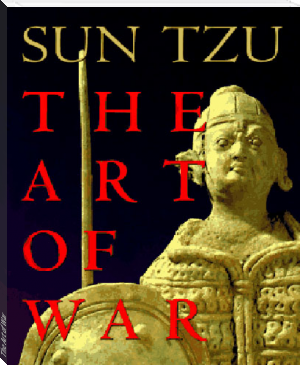The Art of War - Zi Sun (best books to read for success .txt) 📗

- Author: Zi Sun
- Performer: 0976072696
Book online «The Art of War - Zi Sun (best books to read for success .txt) 📗». Author Zi Sun
7. LI CHING PING FA (not to be confounded with the foregoing) is a short treatise in 8 chapters, preserved in the T`ung Tien, but not published separately. This fact explains its omission from the SSU K`U CH`UAN SHU.
8. WU CH`I CHING, in 1 CHUAN. Attributed to the legendary minister Feng Hou, with exegetical notes by Kung-sun Hung of the Han dynasty (d. 121 B.C.), and said to have been eulogized by the celebrated general Ma Lung (d. 300 A.D.). Yet the earliest mention of it is in the SUNG CHIH. Although a forgery, the work is well put together.
Considering the high popular estimation in which Chu-ko Liang has always been held, it is not surprising to find more than one work on war ascribed to his pen. Such are (1) the SHIH LIU TS`E (1 CHUAN), preserved in the YUNG LO TA TIEN; (2) CHIANG YUAN (1 CHUAN); and (3) HSIN SHU (1 CHUAN), which steals wholesale from Sun Tzu. None of these has the slightest claim to be considered genuine. Most of the large Chinese encyclopedias contain extensive sections devoted to the literature of war. The following references may be found useful: —
T`UNG TIEN (circa 800 A.D.), ch. 148-162.
T`AI P`ING YU LAN (983), ch. 270-359.
WEN HSIEN TUNG K`AO (13th cent.), ch. 221.
YU HAI (13th cent.), ch. 140, 141.
SAN TS`AI T`U HUI (16th cent).
KUANG PO WU CHIH (1607), ch. 31, 32.
CH`IEN CH`IO LEI SHU (1632), ch. 75.
YUAN CHIEN LEI HAN (1710), ch. 206-229.
KU CHIN T`U SHU CHI CH`ENG (1726), section XXX, esp. ch. 81-
90.
HSU WEN HSIEN T`UNG K`AO (1784), ch. 121-134.
HUANG CH`AO CHING SHIH WEN PIEN (1826), ch. 76, 77.
The bibliographical sections of certain historical works
also deserve mention: —
CH`IEN HAN SHU, ch. 30.
SUI SHU, ch. 32-35.
CHIU T`ANG SHU, ch. 46, 47.
HSIN T`ANG SHU, ch. 57,60.
SUNG SHIH, ch. 202-209.
T`UNG CHIH (circa 1150), ch. 68.
To these of course must be added the great Catalogue of the
Imperial Library: —
SSU K`U CH`UAN SHU TSUNG MU T`I YAO (1790), ch. 99, 100.
Footnotes ————-
1. SHI CHI, ch. 65.
2. He reigned from 514 to 496 B.C.
3. SHI CHI, ch. 130.
4. The appellation of Nang Wa.
5. SHI CHI, ch. 31.
6. SHI CHI, ch. 25.
7. The appellation of Hu Yen, mentioned in ch. 39 under the year 637.
8. Wang-tzu Ch`eng-fu, ch. 32, year 607.
9. The mistake is natural enough. Native critics refer to a work of the Han dynasty, which says: "Ten LI outside the WU gate [of the city of Wu, now Soochow in Kiangsu] there is a great mound, raised to commemorate the entertainment of Sun Wu of Ch`i, who excelled in the art of war, by the King of Wu."
10. "They attached strings to wood to make bows, and sharpened wood to make arrows. The use of bows and arrows is to keep the Empire in awe."
11. The son and successor of Ho Lu. He was finally defeated and overthrown by Kou chien, King of Yueh, in 473 B.C. See post.
12. King Yen of Hsu, a fabulous being, of whom Sun Hsing-yen says in his preface: "His humanity brought him to destruction."
13. The passage I have put in brackets is omitted in the T`U
SHU, and may be an interpolation. It was known, however to Chang
Shou-chieh of the T`ang dynasty, and appears in the T`AI P`ING YU
LAN.
14. Ts`ao Kung seems to be thinking of the first part of chap. II, perhaps especially of ss. 8.
15. See chap. XI.
16. On the other hand, it is noteworthy that WU TZU, which is not in 6 chapters, has 48 assigned to it in the HAN CHIH. Likewise, the CHUNG YUNG is credited with 49 chapters, though now only in one only. In the case of very short works, one is tempted to think that P`IEN might simply mean "leaves."
17. Yeh Shih of the Sung dynasty [1151-1223].
18. He hardly deserves to be bracketed with assassins.
19. See Chapter 7, ss. 27 and Chapter 11, ss. 28.
20. See Chapter 11, ss. 28. Chuan Chu is the abbreviated form of his name.
21. I.e. Po P`ei. See ante.
22. The nucleus of this work is probably genuine, though large additions have been made by later hands. Kuan chung died in 645 B.C.
23. See infra, beginning of INTRODUCTION.
24. I do not know what this work, unless it be the last chapter of another work. Why that chapter should be singled out, however, is not clear.
25. About 480 B.C.
26. That is, I suppose, the age of Wu Wang and Chou Kung.
27. In the 3rd century B.C.
28. Ssu-ma Jang-chu, whose family name was T`ien, lived in the latter half of the 6th century B.C., and is also believed to have written a work on war. See SHIH CHI, ch. 64, and infra at the beginning of the INTRODUCTION.
29. See Legge's Classics, vol. V, Prolegomena p. 27. Legge thinks that the TSO CHUAN must have been written in the 5th century, but not before 424 B.C.
30. See MENCIUS III. 1. iii. 13-20.
31. When Wu first appears in the CH`UN CH`IU in 584, it is already at variance with its powerful neighbor. The CH`UN CH`IU first mentions Yueh in 537, the TSO CHUAN in 601.
32. This is explicitly stated in the TSO CHUAN, XXXII, 2.
33. There is this to be said for the later period, that the feud would tend to grow more bitter after each encounter, and thus more fully justify the language used in XI.





Comments (0)